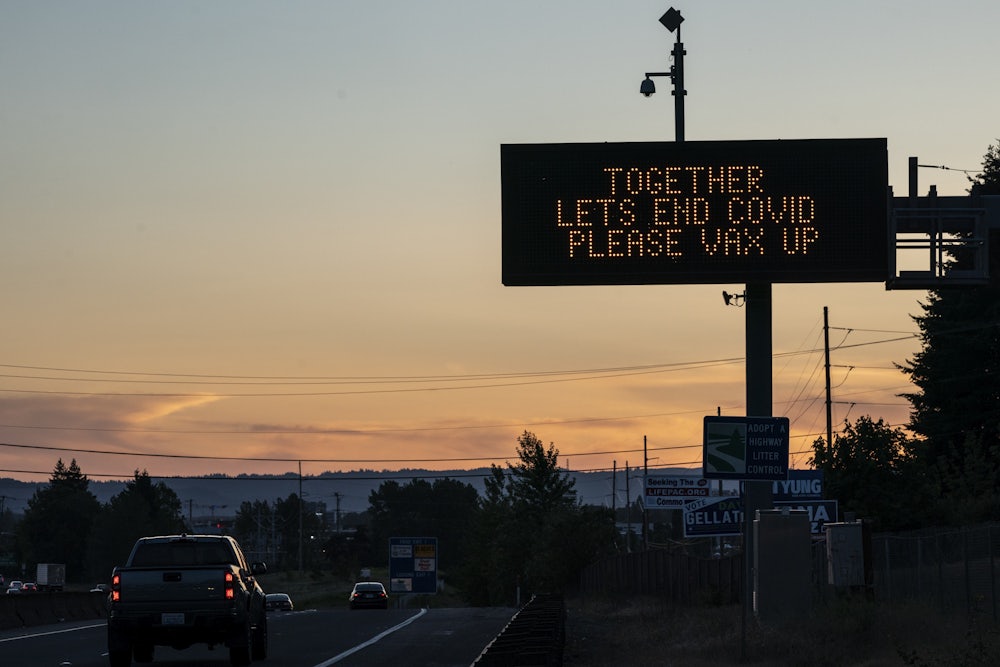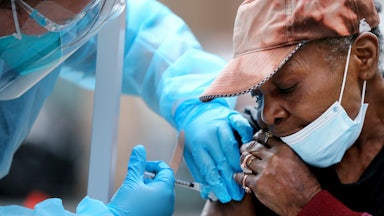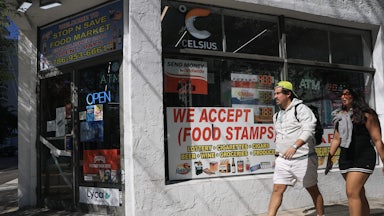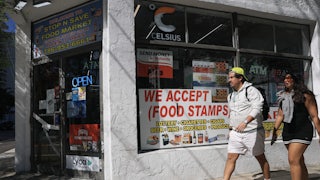The data that underpins the case for getting the Covid-19 vaccines is as irrefutable as it is remarkable: People who have gotten the shot are around 80 percent less likely to get infected, and those who do are nearly 80 percent less likely to transmit the virus to others. The vaccine offers significant protection against severe illness from the virus: Immunized people comprise only 3 percent of hospitalizations and fewer than 1 percent of deaths from Covid-19.
Nonetheless, hospitalizations and deaths are on the rise nationwide, as the highly infectious delta variant poses a dire threat to the half of Americans who haven’t been jabbed. This in turn has prompted the widespread reintroduction of mitigation measures such as indoor masking. Exasperation from the already protected has followed: “Vaccinated America,” as one headline put it, “Is Over It.” The New York Times echoed the sentiment: “As virus cases rise, another contagion spreads among the vaccinated: anger.”
For a growing number of people, the plateauing vaccination rate suggests that tougher measures are long overdue. As Bob Wachter, chair of the Department of Medicine at the University of California, San Francisco, recently put it on Twitter, “It’s clear that gentle persuasion did not achieve the vax rate we need to defeat Covid. Yes, the politics are hard, but dying is worse, as is re-tanking the economy. It’s time for vaccine mandates—nothing else gets us where we need to go.” In an op-ed, Indiana University’s chief health officer, Aaron Carroll, framed things even more succinctly: “When it comes to incentives, most people like carrots. Sometimes, though, people need sticks.”
But those sticks are rife with problems. And however helpful certain strategies may be in compelling certain holdouts finally to get vaccinated, it’s folly to think of them as a substitute for good old-fashioned persuasion. There’s no simple trick to avoid the fact that getting vaccine rates as high as possible will require getting as many people as we possibly can to decide for themselves to take the shot—and we still haven’t made that as easy as it should be.
The “sticks” that are being proposed vary. One of the more abjectly gruesome is charging unvaccinated people more for health insurance, an idea floated by everyone from Kaiser Health News Editor in Chief Elizabeth Rosenthal (and retweeted by Hawaii Senator Brian Schatz) to University of Michigan economist Justin Wolfers. Such a move would be not only cruel but reckless: Among the Affordable Care Act’s greatest achievements was the way it transformed the lives of so many people with preexisting conditions by banning the previously rampant practice of charging patients different prices based on their health.
Undermining this hard-won bedrock protection (which has proven to be a winner at the ballot box, to boot) gives private insurance companies even more undue power over the most intimate parts of our lives, and could pave the way for other exceptions for things that arguably fall under the purview of “personal choice,” reinforcing the exact logic of individualized, market-driven health care that we desperately need to reject. And even if we were callous enough to whack unvaccinated people with this particular stick, it would be highly likely to backfire: The ACA does allow insurers to charge smokers more for coverage, which, instead of prompting them to quit the habit, has merely pushed them off insurance altogether. All the more galling is the fact that smokers, much like the unvaccinated population, are disproportionately poor.
More often, proponents for tougher vaccination strategies call for “mandates.” In recent days, public and private employers have announced a dizzying array of mandates, which have taken various forms. The Department of Veterans Affairs, for instance, has given patient-facing workers eight weeks to get fully vaccinated or face possible removal. Massachusetts has declared that any nursing home receiving state funding must have a fully vaccinated staff or receive no further admissions beyond October 10. Many other employers have simply instituted a choice between getting vaccinated and undergoing frequent testing.
Consumers are targeted by another species of mandate, such as those implemented by event venues and by New York City Mayor Bill DeBlasio, who says the city will require patrons to show proof of vaccination to enter restaurants and gyms. There’s plenty of evidence that such mandates are effective: NYC vax rates reportedly surged by 40 percent following these announcements, which have been accompanied by incentives in the form of $100 gift cards. Elsewhere, Israel and France reported similar boons to their vaccination efforts once vaccination became mandatory in commercial spaces. Mandates of various kinds, the thinking goes, target people with less hardened opposition to the shots by raising the social costs of forgoing the jab. And while mandates may present logistical challenges—how to efficiently replace lost vaccination cards, for example, or who qualifies for a given exemption—they should be encouraged wherever possible.
Nonetheless, it’s important to recognize that the efficacy of mandates has appreciable limits. Even in liberal strongholds like New York City, mandates have sparked protest, such as SEIU 1199’s demonstration in front of New York Presbyterian Hospital. But that’s nothing compared to the political hostility marshaled against mandates in more conservative areas—which are often places with comparatively low vaccination rates that ostensibly need mandates the most. Republican officials in nine states have implemented laws banning vaccine mandates in various contexts, with several of the least vaccinated states represented among them.
While it’s unclear how these bans would stand up to legal challenges, they almost certainly have a chilling effect: After Arizona Republican Governor Doug Ducey filed an executive order barring universities from mandating vaccines, Arizona State backed down from its intention to require masks for unvaccinated students. Even in Indiana, where an appellate court just upheld the public university’s vaccine mandate against a student lawsuit, the school quietly scaled back its policy last month from requiring proof of vaccination to simply requiring a (presumably easily falsifiable) self-report.
By and large, the private employers who may have leeway when it comes to mandating vaccines for their workers are also unlikely to step in heroically where elected officials fail. This dynamic was made crystal clear when Walmart, the nation’s top private employer, announced to great fanfare that it would mandate vaccines for employees—but only its corporate professionals. The retail giant did not apply the rule to its vast number of warehouse and store staff—who are much more likely to be unvaccinated and at higher risk of severe Covid-19 thanks to workplace exposure and social vulnerability.
All of this points to a frustrating fact about vaccine mandates: You can’t lean too hard on them simply because you’re throwing in the towel on persuasion, because the same political and social forces that result in low vaccination rates also make mandates less feasible. And where mandates are implemented, their effectiveness will still rely on broad social support.
The unavoidable truth is that you still have to make people want to take the Covid-19 vaccine to boost vaccination rates to the levels we need them to go. To that end, there’s plenty more that can be done: While a certain portion of unvaccinated people are likely hell-bent against the shot, millions of others are not—and they’re more likely to be Black or Latino, poor, or uninsured than the general population. Put simply, millions of people simply haven’t gotten around to it yet.
However frustrated vaccinated America may be with stalled vaccinations, a basic truth bears repeating: This is a staggeringly large mass immunization campaign of hundreds of millions of people, completely unprecedented in U.S. history, and it was always going to be hard. And it was made even harder by a Congress that held up state and local vaccination funding for months, to such a degree that the money only reached public health departments in early February—months after the vaccine debuted, and months after they’d been forced to improvise a registration process without the cash influx they couldn’t be sure would arrive. That lag was never fully rectified, and many places have still never taken up the sorts of creative, proactive strategies that bring ease, accessibility, and ubiquity to the cause—think vaccination clinics offering incentives at block parties, public parks, and bus stops, for example—and which could reach people who are just beyond the reach of institutions and outside the grasp of any mandate.








